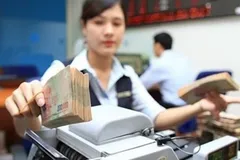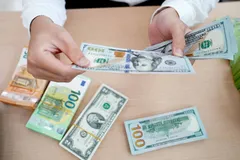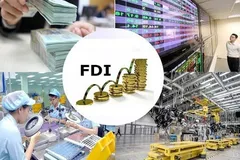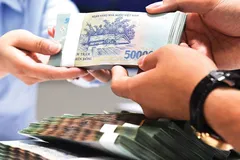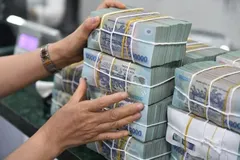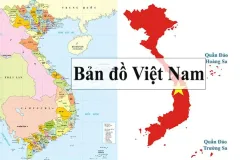
But as the price of gold continues to climb, so too does the gap between domestic and international markets—at times widening to an unprecedented 17–18 million VND (approximately $670–710) per tael. As both investors and regulators watch closely, the big question remains: how will Vietnam manage the market turbulence ahead?
A World Gripped by Gold
The global gold market has experienced relentless volatility over the past five months, with prices hitting record levels more than a dozen times. On April 22, gold peaked at $3,500 per ounce—before cooling slightly in May. Even so, gold has held steady in the $3,180–$3,400 per ounce range over the past month. As of May 22, the spot price hovered around $3,337, marking an explosive 60.3% increase from the start of 2024.
Several factors are fueling this gold rush. Geopolitical instability, escalating military conflicts, and rising tensions among global powers have prompted central banks and institutional investors to bolster their gold reserves. Moreover, economic uncertainty—fueled in part by U.S. President Donald Trump’s recent declaration to impose steep reciprocal tariffs—has sparked global fears of slower growth and a potential trade war. The result? A dramatic pivot toward gold as a safe-haven asset.
A recent report from the European Central Bank (ECB) underscored gold’s renewed appeal. “In times of geopolitical and economic volatility, gold remains a critical hedge for both institutional and sovereign investors,” the ECB noted.
Singapore’s UOB Bank has echoed this sentiment, maintaining a bullish stance on gold with a revised forecast of $3,600 per ounce in early 2026. Goldman Sachs, in a similar move, lifted its year-end 2025 projection to $3,700 per ounce, citing sustained central bank demand and possible capital flows returning to U.S.-based gold ETFs.
Vietnam’s Market Heats Up
While global dynamics are at play, the impact in Vietnam has been uniquely sharp. On April 22, prices for SJC gold bars—the benchmark standard in Vietnam—soared to an all-time high of VND 124 million ($4,870) per tael. Though prices dipped slightly to around VND 120.8 million ($4,740) by May 22, they still reflect a staggering 43% increase since the end of 2024.
Interestingly, domestic gold prices have outpaced international benchmarks, widening the price gap between the two markets. Analysts attribute this to several key factors. First, domestic prices are not directly pegged to global ones, creating room for arbitrage. Second, Vietnamese gold dealers are pricing in risk amid erratic global fluctuations, raising margins to protect against sudden downturns.
Moreover, supply constraints have exacerbated the situation. According to the State Bank of Vietnam (SBV), there has been no official addition to domestic gold reserves since the start of the year. With demand soaring—fueled by expectations of continued global instability—the limited availability has created a classic squeeze: more buyers chasing fewer goods.
Speculation and Risk: A Growing Concern
Vietnamese authorities are growing increasingly concerned about market manipulation and speculative behavior. While the SBV has not intervened directly so far—citing general market stability—officials acknowledge that some individuals and organizations may be exploiting the situation for short-term profit.
In response, the Prime Minister issued Directive 64, tasking the SBV with tightening oversight and coordinating with other regulatory bodies to maintain market stability. The SBV has been instructed to closely monitor both domestic and international gold prices, remain ready to implement stabilization measures if necessary, and report back to the government with updates through May.
Despite warnings from authorities and financial experts, retail investors continue to pour into gold—often ignoring the risks. Even after government and SBV statements led to short-term price corrections, the overall upward trend has persisted. “We advise against chasing the market,” said one SBV official. “Buying at the top based on crowd mentality can lead to significant losses.”
Still, many Vietnamese see few better alternatives. With interest rates on savings accounts at historic lows and equities underperforming, gold stands out as one of the few asset classes delivering strong returns. And despite the limited physical supply, investors are increasingly turning to online platforms to buy and sell gold—an approach not without its own risks, including fraud and cybersecurity vulnerabilities.
What Lies Ahead?
Looking forward, the Vietnamese government faces a delicate balancing act. It must protect retail investors, curb speculation, and preserve macroeconomic stability—all while avoiding direct interventions that could backfire or distort the market further.
“We must ensure that developments in the gold market do not destabilize the exchange rate, interest rate, or broader monetary and financial systems,” the Prime Minister emphasized in his directive.
To that end, policy options on the table include increasing transparency in the gold trading system, expanding supply channels through authorized import quotas, and reviewing the current framework that links domestic pricing to global trends.
At the same time, public awareness campaigns may become more prominent, urging individuals to make informed investment decisions rather than chasing short-term gains.
The trajectory of gold prices—both globally and in Vietnam—remains uncertain. But one thing is clear: the stakes are high. For Vietnamese regulators, the challenge will be to respond quickly and wisely to an ever-evolving market without triggering further volatility. For investors, the message is simple but critical: proceed with caution.
As the global and domestic factors continue to evolve, all eyes will be on how Vietnam adapts its gold market policies in the coming months—and whether the precious metal will continue to shine, or begin to lose its luster.


